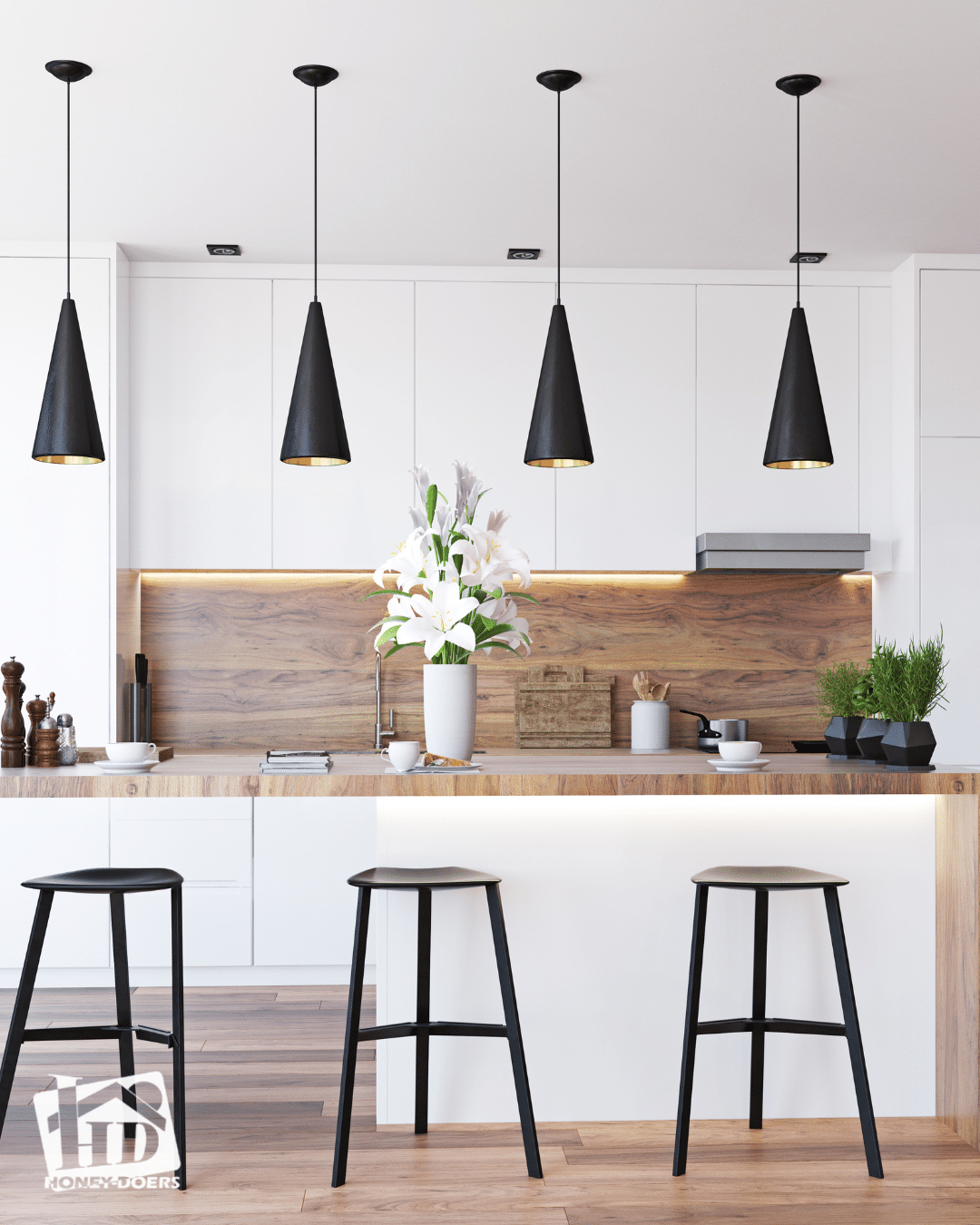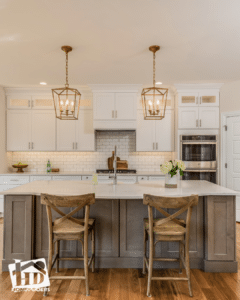The Historical Evolution of Kitchen Lighting
The kitchen, often referred to as the heart of the home, has seen a remarkable transformation in its lighting solutions over the years. Understanding the historical evolution of kitchen lighting not only sheds light on the past but also provides valuable insights for those wondering how to choose kitchen lighting today.
Early Modern Kitchens: The Era of Natural and Simple Lighting
In the early modern period, kitchen lighting was predominantly natural, relying on daylight. Windows were the primary source of illumination. During the evening, simpler forms of lighting like candles and oil lamps were common. These sources provided a warm, albeit dim, glow, which was sufficient for the less complex kitchen tasks of the time.
The Revolutionary Impact of Electricity
The advent of electricity in the late 19th and early 20th centuries revolutionized kitchen lighting. The introduction of electric bulbs meant kitchens could be illuminated more brightly and efficiently than ever before. This technological advancement was a game-changer, making it easier to perform detailed tasks and improving the overall safety of the kitchen environment.
Decade by Decade: A Journey Through Kitchen Lighting Styles
- 1950s: Post World War II, kitchens began to reflect a sense of optimism and prosperity. Bright, overhead ceiling lights for kitchens became popular, often with decorative elements. Fluorescent lighting also made its way into the kitchen, offering a more even light distribution.
- 1980s: This era saw a shift towards more focused and layered lighting. Track lighting and recessed fixtures became popular, allowing homeowners to direct light where it was most needed. This period also marked the beginning of a trend towards more energy-efficient kitchen light fixtures.
- 2000s and Beyond: The new millennium has seen a surge in eco-friendly and smart lighting solutions. LED technology has become commonplace for its energy efficiency and longevity. Modern kitchen lighting now often includes under-cabinet lights and over the sink lighting, focusing on areas where tasks are performed.
Cultural and Technological Influences on Kitchen Lighting Trends
As kitchens evolved from purely functional spaces to central areas for family interaction and entertainment, so too did the approach to lighting. The rise of open-plan living has seen kitchen lighting become more integrated with the home’s overall design aesthetic.
Modern Kitchen Lighting Technologies: Brightening Up the Heart of the Home
The world of kitchen lighting has evolved dramatically, with modern technologies transforming the way we illuminate this central space in our homes. For those pondering how to choose kitchen lighting, understanding these technologies is key to making informed decisions. Let’s explore the cutting-edge advancements in kitchen light fixtures and how they combine efficiency with style.
The Latest in Kitchen Lighting Technology
- LED Lighting: The most significant leap in kitchen lighting technology has been the widespread adoption of LED (Light Emitting Diodes) lighting. LEDs have revolutionized kitchen lighting with their energy efficiency, long lifespan, and versatility. They come in various forms, including strips, pucks, and bulbs, making them suitable for ceiling lights for the kitchen, under-cabinet lighting, and over the sink lighting.
- Smart Lighting Systems: Integration with home automation systems has made kitchen lighting smarter than ever. Smart bulbs and fixtures can be controlled via smartphones or voice assistants, allowing you to adjust brightness, color temperature, and even the color of the light to suit different moods or tasks.
- Motion Sensors and Dimmers: Modern kitchens often feature motion sensor lighting, which turns on lights automatically when someone enters the room and turns them off when the room is vacant. Dimmers have also become more sophisticated, allowing for seamless adjustment of light levels, thereby saving energy and creating ambiance.
Energy Efficiency: A Brighter Future
Modern kitchen lighting is not just about aesthetics; it’s also about sustainability. LED lights consume significantly less energy compared to traditional incandescent bulbs. This not only helps reduce electricity bills but also minimizes the environmental footprint of your home. Many modern kitchen lighting solutions are designed to optimize light output while minimizing energy consumption, making them a win-win for both homeowners and the planet.
Affordable Modern Lighting Solutions
Thinking that modern lighting solutions are expensive is a common misconception. In reality, there are numerous affordable options:
- LED Strip Lights: These are cost-effective and can be easily installed under cabinets or around kitchen islands for a sleek, modern look.
- Recessed LED Downlights: These provide a clean, streamlined look and can be strategically placed to illuminate work areas without breaking the bank.
- Pendant Lights: Available in a range of styles and sizes, pendant lights offer a cost-effective way to add personality and focused lighting over kitchen islands or dining areas.
Integration with Smart Home Technology
The integration of kitchen lighting with smart home technology has been a game-changer. It allows for greater control and customization:
- Remote Control: You can now adjust kitchen lighting from anywhere using your smartphone. This is particularly useful for setting the right mood or ensuring lights are off when you’re away.
- Voice Control: Integration with devices like Amazon Alexa or Google Home means you can control lighting with simple voice commands – perfect for when your hands are full.
- Customizable Scenes: Smart lighting systems allow you to create and save lighting “scenes” – for instance, a bright, cool light for cooking and a warm, dim light for dining.
Guidance to Choosing Kitchen Lighting
Choosing the right kitchen lighting involves more than just picking out stylish fixtures; it’s about functionality, aesthetics, and creating the right mood. Below, we delve into various aspects of kitchen lighting, offering practical advice on how to select the perfect lighting solutions for your kitchen.
Placement: Illuminating Key Areas
- Key Areas Requiring Lighting: The main areas in a kitchen that require effective lighting are the countertops, sink, and stove areas, as these are the primary workspaces. Additionally, kitchen islands, dining areas, and pantry spaces should also be well-lit.
- Impact of Lighting Placement: Strategic placement of lighting can dramatically affect both the functionality and aesthetics of a kitchen. Task lighting should be focused on work areas to facilitate safe cooking and food preparation, while ambient lighting can create a warm and welcoming atmosphere. Accent lighting can highlight architectural features or decor.
- Creative Solutions for Small Spaces: In smaller or unconventional kitchens, utilizing under-cabinet lighting can maximize space and efficiency. Pendant lights over dining areas or kitchen islands can also add style without occupying much space.
Color: Setting the Mood with Light
- Effect of Light Color on Mood and Usability: The color of light can significantly impact the mood of a kitchen. Warmer tones create a cozy and inviting atmosphere, ideal for dining areas, while cooler tones are better suited for task-oriented spaces, providing a more focused environment.
- Recommended Color Temperatures: For task lighting, a cooler temperature of around 4000K is often recommended, as it provides a crisp, clear light. For ambient lighting, warmer temperatures, around 2700K to 3000K, are preferable for a relaxing environment.
- Using Different Colors for Activities: Adjustable or multicolored LED lights can be used to change the kitchen’s mood depending on the activity. Bright, cool light is ideal for cooking and cleaning, while a softer, warmer light can create a pleasant ambiance for dining or entertaining.
Fixtures: Trends and Selection Tips
- Trends in Kitchen Light Fixtures: Modern kitchen lighting trends include minimalist designs, industrial-style fixtures, and smart, LED lighting solutions. There’s also a rise in using natural materials like wood and stone in light fixtures, adding warmth and texture to kitchen spaces.
- Choosing the Right Style for Your Kitchen: The choice of fixture style should complement the overall design of your kitchen. For modern kitchens, sleek and simple designs work best. Rustic kitchens can be enhanced with fixtures that incorporate natural elements. Minimalist kitchens benefit from fixtures with clean lines and a lack of ornamentation.
- Considerations for Specific Areas: Over the sink, lighting should be bright and focused, with waterproof features being an added advantage. For kitchen islands, pendant lights or a series of smaller fixtures can provide both task and ambient lighting.
Brightness: Achieving the Perfect Balance
- Ideal Brightness for Kitchens: The ideal brightness depends on the size and color palette of your kitchen. Generally, a mix of different types of lighting at varying levels of brightness is best to cater to different needs and times of the day.
- Balancing Brightness and Comfort: Using dimmers can help adjust the light intensity based on the task at hand or the time of day. Layering light with a combination of task, ambient, and accent lighting also helps balance brightness and comfort.
- Adjustable Lighting for Flexibility: Adjustable lighting solutions, such as dimmers and smart lights, are perfect for creating a flexible lighting environment that can adapt to different activities, whether it’s bright lighting for meal prep or subdued lighting for a cozy dinner.
When considering how to choose kitchen lighting, remember that it’s about blending functionality with aesthetics. From kitchen light fixtures to ceiling lights for the kitchen, and over the sink lighting, each element plays a crucial role in creating a practical and inviting space. Whether you’re updating your modern kitchen lighting or starting from scratch, these guidelines will help you illuminate your kitchen in the best possible way.
Practical Tips and Tricks for Kitchen Lighting Upgrades
Upgrading your kitchen lighting doesn’t have to be an expensive or daunting task. With a few practical tips and a bit of creativity, you can significantly enhance the look and functionality of your kitchen lighting. Here’s how you can balance aesthetics, function, and budget in your kitchen lighting choices.
Budget-Friendly Upgrades for Kitchen Lighting
- Repurpose Existing Fixtures: Before you rush to buy new fixtures, consider repurposing or updating your existing ones. Sometimes, a fresh coat of paint or new lampshades can make a big difference.
- Shop Sales and Discounts: Keep an eye out for sales at home improvement stores or online marketplaces. You can often find high-quality kitchen light fixtures at a fraction of their original price.
- Use LED Bulbs: Switching to LED bulbs in your existing fixtures is a cost-effective way to update your kitchen lighting. LEDs last longer and consume less energy, saving money in the long run.
Combining Aesthetics and Functionality
- Layer Your Lighting: Incorporate a mix of ambient, task, and accent lighting. This not only creates a visually appealing space but also ensures that you have the right type of light where you need it.
- Choose Multi-Functional Fixtures: Look for fixtures that serve multiple purposes. For example, under-cabinet lighting can provide both task lighting for food prep and ambient lighting for a soft glow in the evening.
- Consider the Color Scheme: Ensure your light fixtures complement the color scheme of your kitchen. For instance, warmer lights work well with earthy tones, while cooler lights pair nicely with modern, minimalist designs.
DIY Kitchen Lighting Projects
- Install Dimmer Switches: Adding dimmer switches is a simple DIY project that can greatly enhance the ambiance of your kitchen. They allow you to adjust the brightness of your lights, creating the perfect mood for any occasion.
- Create Your Own Pendant Lights: With some basic wiring knowledge, you can turn items like mason jars, old wine bottles, or woven baskets into unique pendant lights for over the kitchen island or dining area.
- Add LED Strip Lights: LED strip lights are easy to install and can be placed under cabinets, inside glass cabinets, or around the base of the island for an instant upgrade.
Illuminating Your Kitchen Redesign Journey
Embarking on a kitchen lighting redesign can be an exciting journey, transforming the space into a bright, functional, and inviting area. Here’s how you can get started, avoid common pitfalls, and how Honey-Doers Home Remodeling can guide you every step of the way.
Getting Started with Your Kitchen Lighting Redesign
- Assess Your Current Lighting: Take stock of your existing lighting. Identify what works, what doesn’t, and what areas could benefit from improved lighting.
- Set Your Goals: Determine what you want to achieve with your lighting redesign. Is it more brightness, energy efficiency, or a modern aesthetic? Defining your goals will guide your decisions.
- Gather Inspiration: Look for ideas online, in magazines, or in showrooms. Pay attention to the different lighting styles, placements, and fixtures that catch your eye.
Avoiding Common Kitchen Lighting Mistakes
- Overlooking Task Lighting: Don’t just focus on the aesthetic. Ensure that work areas like countertops and sinks have adequate task lighting.
- Ignoring Dimmers: Dimmers are essential for creating adaptable lighting environments. They allow you to change the ambiance and save energy.
- Neglecting Scale and Proportion: Ensure that your light fixtures are proportionate to your kitchen space and furniture. Overly large or small fixtures can disrupt the harmony of your design.
How Honey-Doers Home Remodeling Can Help
- Expert Consultation: Our team at Honey-Doers Home Remodeling can provide personalized consultations to help you determine the best lighting solutions for your kitchen. We consider your space, style preferences, and functional needs.
- Professional Installation: From ceiling lights for the kitchen to intricate modern kitchen lighting systems, our skilled technicians ensure a seamless and safe installation process.
- Customized Solutions: Whether it’s over the sink lighting or the latest in LED technology, we offer tailored solutions that align with your budget and design aspirations.
Take the First Step Today
Ready to transform your kitchen with the perfect lighting? Start by exploring our wide range of services at Honey-Doers Home Remodeling. Our team is committed to helping you bring your vision to life, ensuring your kitchen is not just well-lit but also reflects your personal style and needs.
Contact us today to schedule a consultation and take the first step towards a brighter, more beautiful kitchen. With Honey-Doers Home Remodeling, you’re not just redesigning your kitchen lighting; you’re elevating your entire home experience.






